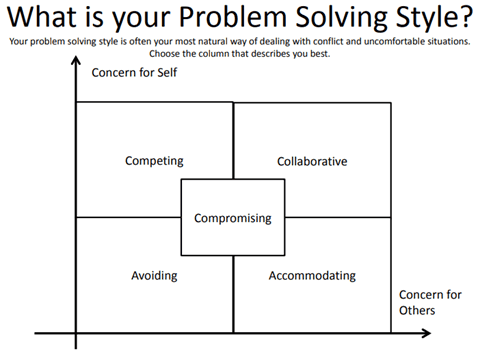
Problem Solving Methods Exercise
Problem Solving Methods helps the team evaluate the way they manage problems in the organization and seeks ways through discussion how they can improve on it. This exercise uses the popular conflict resolution chart that plots “concern for self” against “concern for others”.
While this chart may not explain everything, it serves as a good bridge for open discussion in a conflict situation. With this exercise we help each participant understand their own conflict resolution style and understand the resolution methods adopted by the team.
Explain the purpose of the activity and spend some time to define the five terms that are in the Problem Solving Methods chart. It is important to define each of the terms as well as possible because it is needed for the next part of the exercise.

Once these points have been defined, each participant must be given their own Problem Solving Methods sheet. Each participant must choose on their sheet the quadrant in which they believe their own conflict management style lies, whether competitive, avoidant, compromising, accommodating or collaborative.
After about 15 minutes, the facilitator compiles and the sheet, counting the number of participants that chose each problem solving style. Give extra weight (3 points) to the leader or manager’s sheet because he usually has greater influence in the team.
The Problem Solving style that is chosen the most is usually the team’s conflict management style as well. Ask each participant to talk about one or two incidents that reflect this Problem Solving style of the team.
End the activity by reflecting as a group on these two questions. What insights have you gained from this short exercise? What improvements can be made to the problem solving methods that the team currently uses?


